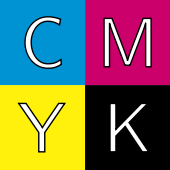CMYK Color Model
 Color printing typically uses ink of four colors: cyan, magenta, yellow, and key (black). When CMY "primaries" are combined at full strength, the resulting "secondary" mixtures are red, green, and blue.
Color printing typically uses ink of four colors: cyan, magenta, yellow, and key (black). When CMY "primaries" are combined at full strength, the resulting "secondary" mixtures are red, green, and blue.
Mixing all three theoretically results in black, but imperfect ink formulations do not give true black, which is why the additional K component is needed.
The CMYK color model (process color, four color) is a subtractive color model, used in color printing, and is also used to describe the printing process itself. CMYK refers to the four inks used in some color printing: cyan, magenta, yellow, and key (black). Though it varies by print house, press operator, press manufacturer, and press run, ink is typically applied in the order of the abbreviation.
The "K" in CMYK stands for key because in four-color printing, cyan, magenta, and yellow printing plates are carefully keyed, or aligned, with the key of the black key plate. Some sources suggest that the "K" in CMYK comes from the last letter in "black" and was chosen because B already means blue. The CMYK model works by partially or entirely masking colors on a lighter, usually white, background. The ink reduces the light that would otherwise be reflected. Such a model is called subtractive because inks "subtract" brightness from white.
In additive color models such as RGB, white is the "additive" combination of all primary colored lights, while black is the absence of light. In the CMYK model, it is the opposite: white is the natural color of the paper or other background, while black results from a full combination of colored inks. To save money on ink, and to produce deeper black tones, unsaturated and dark colors are produced by using black ink instead of the combination of cyan, magenta and yellow.
Source: http://en.wikipedia.org/wiki/CMYK_color_model

